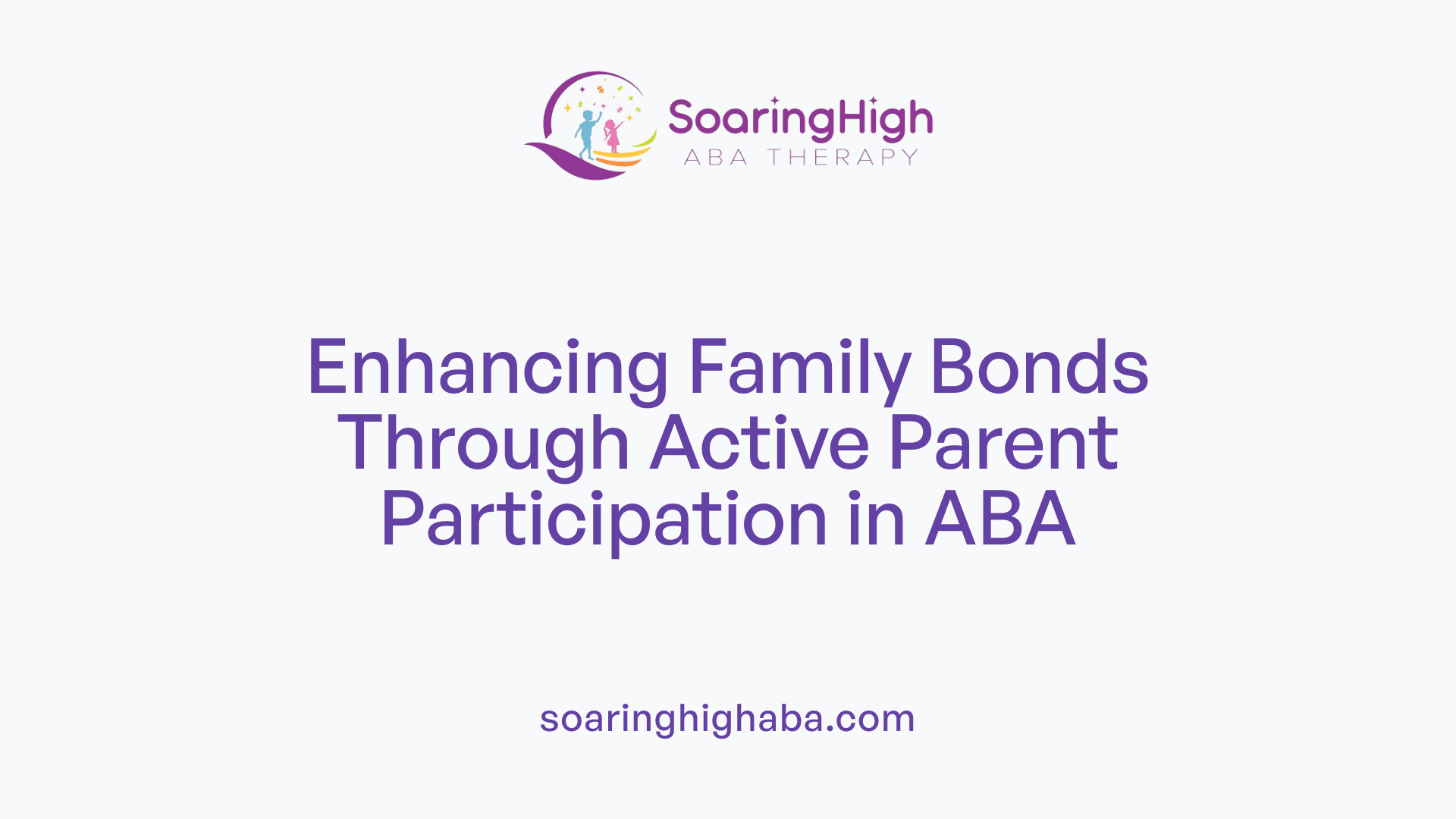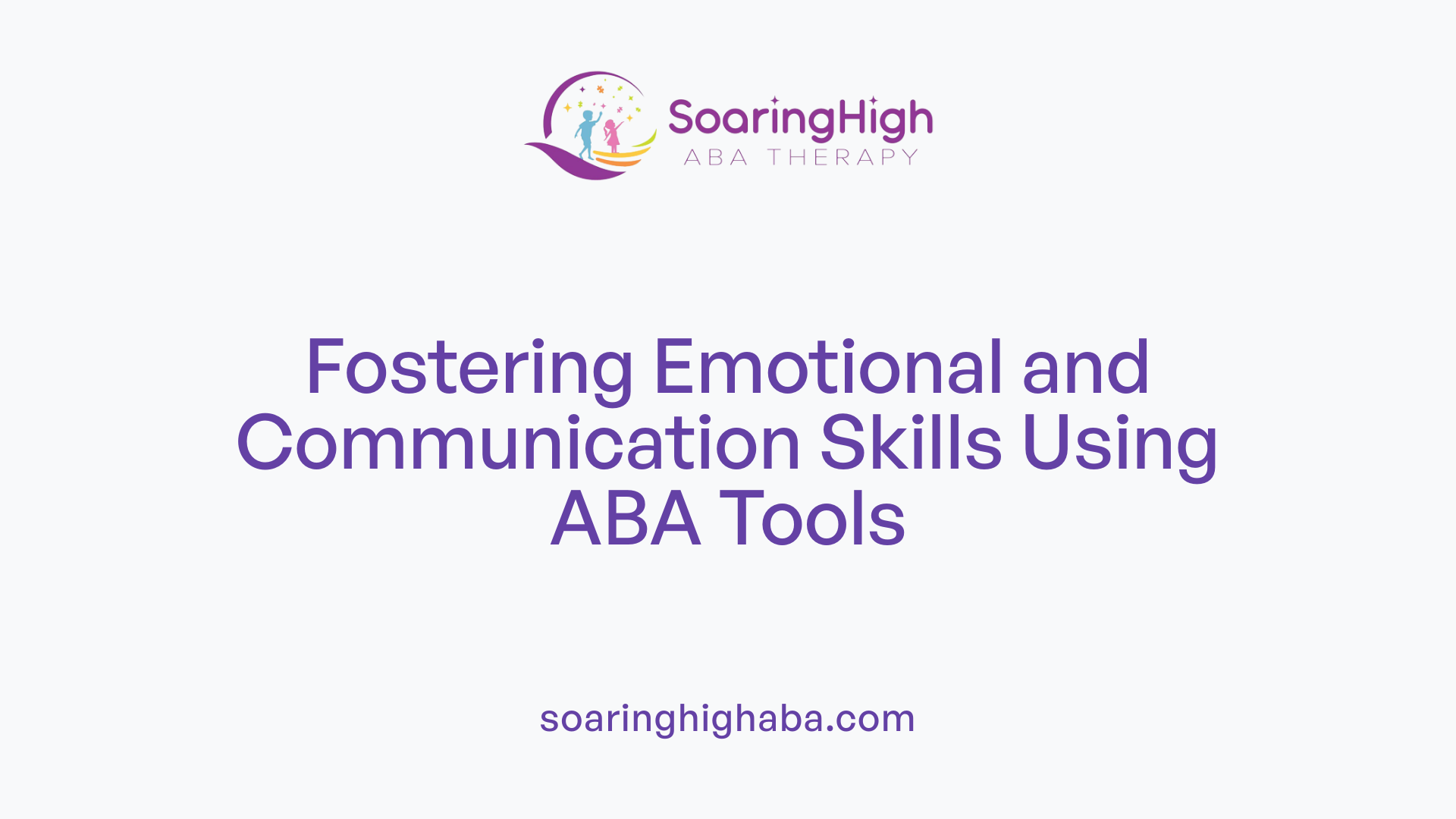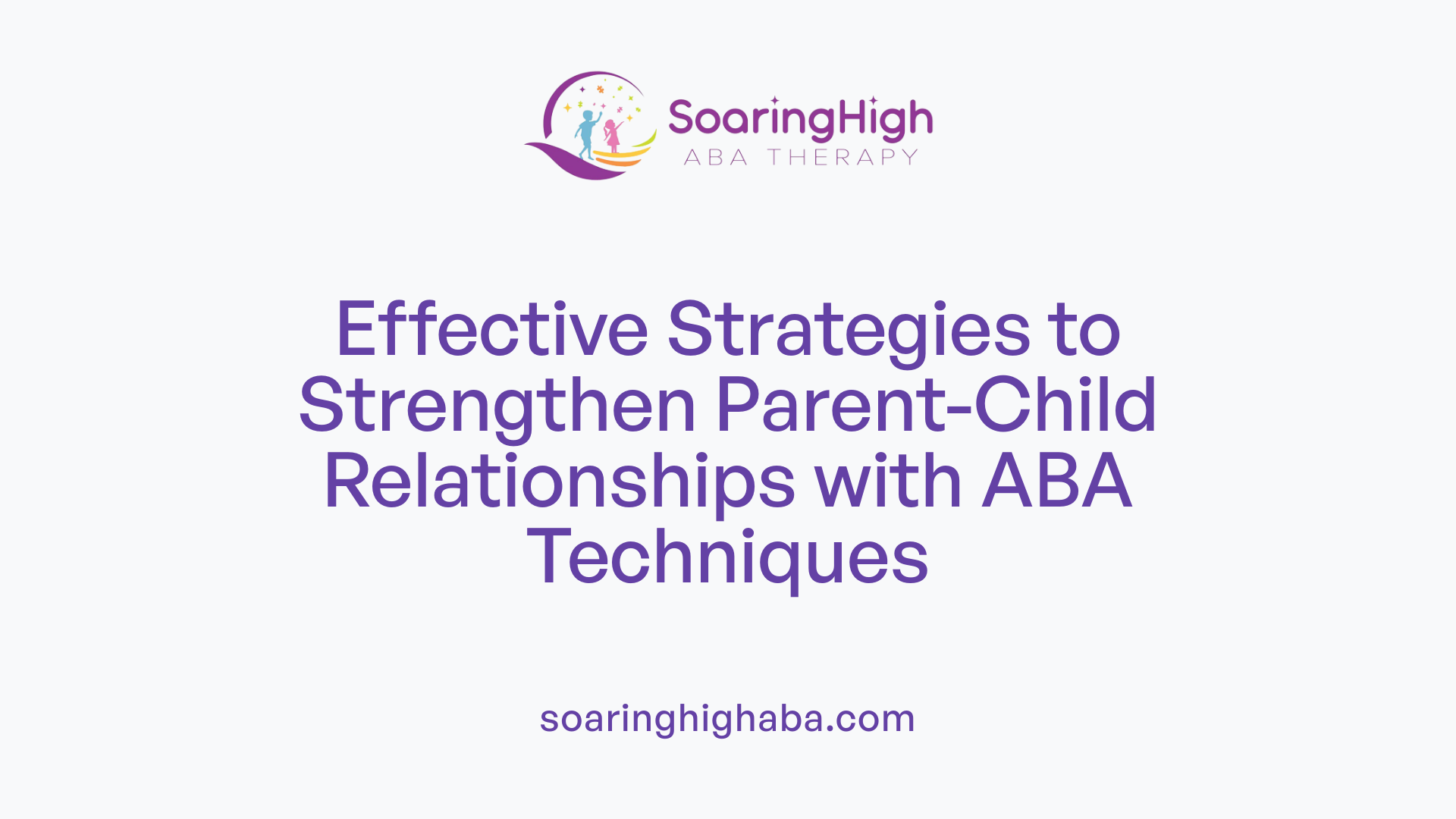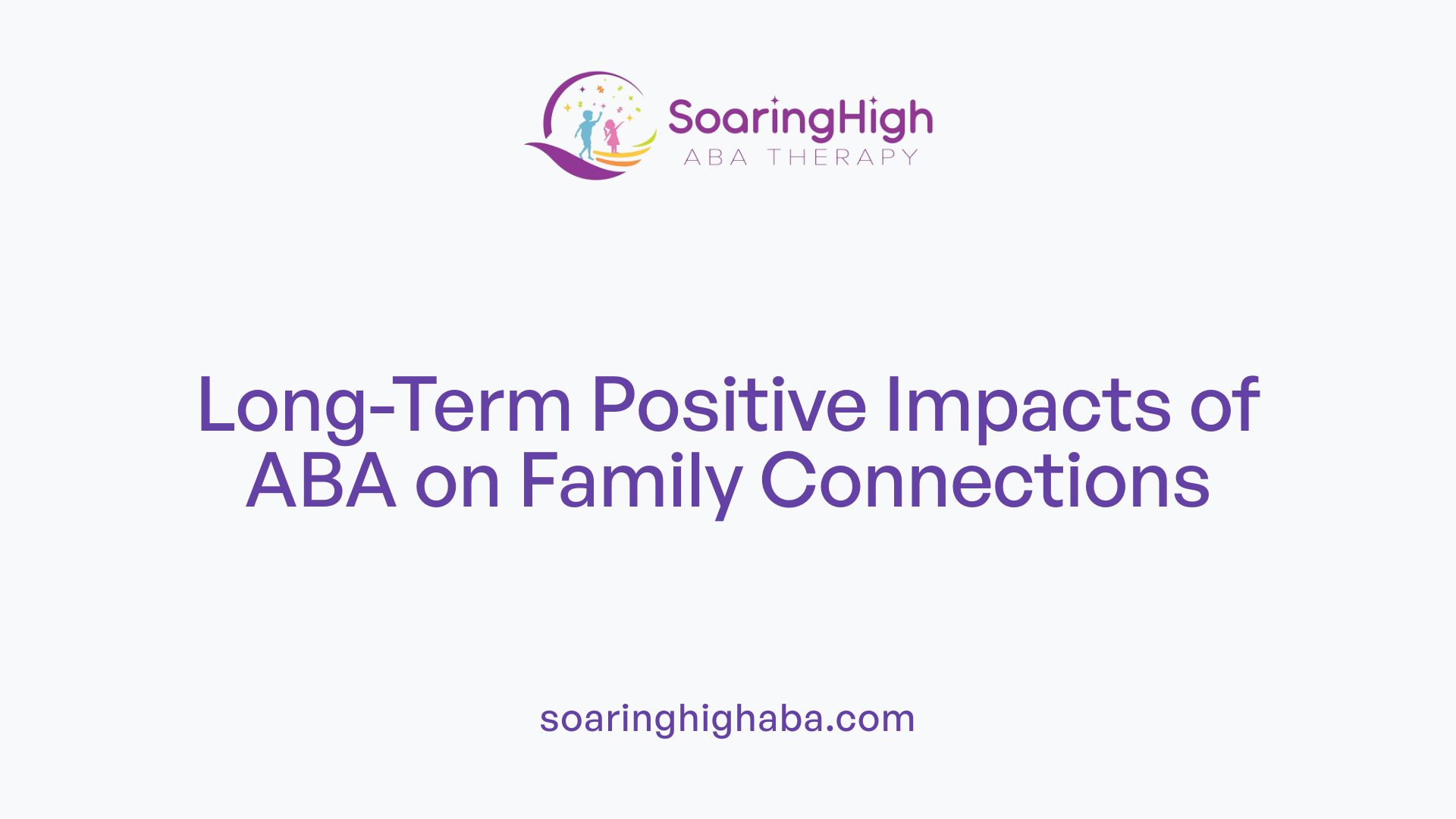The Power of ABA Therapy in Family Relationships
Applied Behavior Analysis (ABA) therapy has emerged as a transformative approach in supporting children with autism and developmental challenges. Beyond its clinical effectiveness, ABA therapy also plays a vital role in strengthening the emotional and relational fabric of families. When parents actively participate in their child's therapy journey, they gain tools, understanding, and confidence that foster deeper connections, improved communication, and mutual trust. This article explores how ABA therapy not only promotes developmental progress but also nurtures healthier, more resilient family bonds.
The Role of Parent Involvement in Strengthening Family Bonds

How does parent involvement in ABA therapy contribute to better familial bonds?
Parent participation in ABA therapy plays a vital role in nurturing stronger family relationships. When parents are actively engaged in the therapeutic process, they gain a deeper understanding of their child's behaviors, triggers, and needs. This knowledge fosters empathy and patience, creating a more supportive environment at home.
Training sessions equip parents with effective strategies, such as positive reinforcement and communication techniques, which they can consistently apply outside therapy sessions. This consistency helps children feel more secure, encouraging trust and emotional closeness within the family.
Furthermore, shared involvement in therapy milestones and progress celebrates collective achievements. These moments reinforce a sense of teamwork, and provide opportunities for joy and pride, which strengthen familial bonds.
Active participation also promotes open communication, allowing family members to express concerns, share insights, and work toward common goals. Empowered and confident parents are better equipped to handle challenges, reducing stress and enhancing overall family dynamics.
In summary, parental involvement in ABA therapy not only supports the child's development but also fosters understanding, trust, and emotional connection among family members, creating a more cohesive and nurturing home environment.
Enhancing Family Dynamics and Emotional Bonds Through ABA
What role does ABA therapy play in improving family dynamics and emotional bonds?
ABA therapy significantly benefits family life by fostering better communication, mutual understanding, and a supportive environment. It involves parents actively in the therapy process, which builds their confidence and equips them with effective strategies to support their child's growth.
Through parent training and involvement, families learn to implement consistent behavioral strategies at home, creating a structured, predictable routine that contributes to stability. This stability is essential for reducing stress and minimizing behavioral issues.
The therapy promotes positive interactions within the family, encouraging shared achievements and milestones. Celebrating these successes together strengthens emotional bonds and gives families a sense of collective progress.
ABA also enhances sibling relationships by teaching effective communication and social skills, making interactions more positive and less stressful. As children develop new skills and better manage their behaviors, families often experience increased social engagement and participation in community activities.
Overall, ABA supports families by enhancing communication, reducing chaos, and strengthening emotional ties among family members, leading to a more harmonious and resilient household.
How does ABA therapy support communication improvements?
ABA techniques like social modeling, prompting, and natural environment teaching help children improve their expressive and receptive language skills. These strategies not only aid in better understanding and expressing needs but also facilitate smoother parent-child interactions.
What is the importance of structured routines and stability?
Implementing routines in daily life reinforces positive behaviors, provides security, and helps children feel safe. These routines help reduce anxiety and behavioral problems, fostering a trusting environment where learning can thrive.
How are shared achievements and milestones beneficial?
Progress marked by milestones—such as increased independence or improved communication—serves as motivational rewards for the family. Celebrating these moments together deepens emotional bonds and enhances family cohesion.
How does ABA therapy impact sibling relationships?
ABA strategies promote social play, shared activities, and joint attention, which improve sibling interactions. Teaching children to communicate effectively and share experiences leads to more positive relationships and a supportive family atmosphere.
Building Emotional and Communication Skills with ABA Techniques

How do ABA techniques support emotional connection and communication between parents and children?
ABA techniques play a vital role in enhancing emotional bonds and improving communication within families. These strategies teach children to recognize, understand, and express their feelings more effectively.
One common method involves the use of visual supports, such as emotion cards, charts, and social stories. These tools help children identify different emotions and learn appropriate responses, which fosters empathy and social skills.
Modeling and role-playing are also important components. Through these activities, children observe and practice emotional responses in a safe environment. This not only enhances their emotional understanding but also encourages parents to engage empathetically.
Positive reinforcement is used to motivate children to apply their emotional skills during real-life interactions. Praising and rewarding appropriate emotional expressions reinforce their behavior and build confidence.
Parents are trained to incorporate these techniques consistently at home, promoting the generalization of emotional understanding beyond therapy sessions. This consistency strengthens emotional bonds and nurtures trust.
Overall, ABA strategies foster emotional development by providing structured, evidence-based approaches that help children communicate and relate more effectively, deepening parent-child relationships and emotional connection.
Strategies and Methods for Fostering Parent-Child Connections
 ABA therapy employs several effective approaches to strengthen the relationship between parents and children. First, positive reinforcement is a cornerstone, where desirable behaviors are encouraged through praise, rewards, or preferred activities. This method not only promotes learning but also builds trust and understanding.
ABA therapy employs several effective approaches to strengthen the relationship between parents and children. First, positive reinforcement is a cornerstone, where desirable behaviors are encouraged through praise, rewards, or preferred activities. This method not only promotes learning but also builds trust and understanding.
Structured routines and visual aids play a supportive role in creating a predictable environment. Visual schedules, picture cards, and other visual tools help children understand daily activities and express their needs more clearly, which reduces frustration and increases communication.
Parent training combined with real-time feedback during therapy sessions is vital. Parents learn strategies like modeling appropriate behaviors and engaging in role-playing to foster social skills. Immediate feedback from therapists guides them on how to reinforce these skills consistently at home, deepening their confidence and strengthening their bond with their child.
Creating sensory-friendly settings is also important. ABA techniques such as sensory diets and desensitization exercises help children manage sensory sensitivities, leading to calmer behaviors and more positive parent-child interactions. A sensory-friendly environment supports emotional regulation, making daily exchanges more enjoyable.
Overall, these methods promote a collaborative, supportive, and personalized approach. They facilitate consistent, meaningful interactions that enhance emotional security and mutual understanding between parents and children.
| Strategy | Description | Impact |
|---|---|---|
| Positive reinforcement | Using praise, rewards, and preferred activities to encourage desirable behaviors. | Builds trust, motivates progress, and enhances emotional bonds. |
| Visual aids and routines | Employing picture schedules and visual tools to guide daily activities and communication. | Reduces stress, improves understanding, and supports independence. |
| Parent training and feedback | Educating parents during therapy with real-time coaching and feedback. | Enhances parental engagement, consistency, and effectiveness of interventions. |
| Sensory-friendly environments | Adjusting settings to meet sensory needs, including sensory diets and desensitization. | Promotes emotional regulation and reduces sensory-related stress. |
This multifaceted approach ensures that therapy not only addresses behavioral goals but also nurtures a stronger, more trusting relationship between parents and their children, fostering a positive familial environment.
Long-Term Effects of ABA on Family Relationships

What are the long-term impacts of ABA therapy on family relationships and emotional intimacy?
Research shows that ABA therapy can lead to lasting positive changes in family dynamics. One of the main benefits is the improvement in communication skills for children with autism or developmental challenges. As these children learn to express their needs and emotions more effectively, families experience deeper emotional connections.
Moreover, ABA's focus on developing social skills encourages children to engage more meaningfully with family members. This not only boosts understanding and empathy but also creates shared moments of joy and achievement.
With ongoing therapy, behavioral issues tend to decrease, which reduces everyday stresses and conflicts in the household. As children gain independence and behavioral stability, families often report feeling more cohesive and supportive.
Ultimately, sustained ABA interventions help foster a warm, understanding, and emotionally rich environment. Families grow closer, finding new ways to connect and support each other's growth, which can have long-lasting benefits for all members.
ABA's Framework: Data-Driven and Individualized Approaches
How does ABA therapy support emotional connection and communication between parents and children?
ABA techniques foster emotional bonds and improve communication by teaching children to recognize and express their feelings. Using visual aids like emotion cards, social stories, and charts helps children understand emotions and triggers.
Modeling behaviors and role-playing scenarios show children appropriate ways to respond emotionally, promoting empathy and social understanding. Positive reinforcement encourages the use of emotional skills in everyday interactions, reinforcing trust and strengthening relationships.
Caregiver training ensures parents and other family members implement strategies consistently at home, which helps children generalize their emotional and communicative skills beyond therapy sessions. This consistent reinforcement deepens emotional connections and trust.
Overall, ABA provides structured, evidence-based tools that enhance understanding, emotional development, and meaningful engagement between parents and children.
Creating a Supportive Community and Promoting Self-Care

Why is family involvement and support crucial for successful ABA therapy?
Family participation plays a significant role in the success of ABA therapy. When parents and caregivers are actively engaged, they help reinforce the strategies learned during therapy sessions, encouraging consistent behavior management across various settings. This consistency makes it easier for children to generalize skills, such as communication and social interaction, into their daily lives.
Involving family members through parent training programs equips them with practical tools and techniques to support their child's development. These programs often include teaching reinforcement methods, designing structured routines, and understanding individual behavioral triggers, fostering a nurturing and understanding environment.
Support groups and community resources serve as vital touchpoints for families. They provide emotional support, shared experiences, and valuable advice, reducing parental stress and feelings of isolation. Connecting with other families facing similar challenges fosters a sense of community, empowering parents and caregivers.
Self-care is essential for maintaining the well-being of parents. Techniques such as stress management exercises, relaxation practices, and time management strategies help parents remain resilient and patient. When caregivers are supported and cared for, they are better equipped to provide consistent, responsive care and sustain the benefits of ABA therapy.
Building networks of support enhances these efforts. Families can participate in local or online support groups, attend workshops, and engage with healthcare professionals, creating a robust support system. Such networks foster shared learning, emotional relief, and strength within the family community.
How does involving families in ABA enhance overall therapy outcomes?
When families are involved, there is an increased likelihood of consistent application of behavioral strategies at home and in other settings. This ongoing reinforcement is critical for long-term success. Furthermore, shared milestones and progress celebrate collective effort, strengthening emotional bonds.
In summary, family involvement, through training, support networks, and self-care, elevates the effectiveness of ABA therapy. It nurtures a supportive environment that encourages growth, resilience, and stronger familial relationships, ultimately leading to improved developmental outcomes for children with autism.
A Holistic Approach to Family Well-being
ABA therapy, especially when involves active parent participation, creates a ripple effect of positive change that extends beyond the child's developmental gains. It fosters understanding, collaboration, and emotional intimacy, transforming family dynamics and strengthening bonds. By integrating structured routines, visual supports, and collaborative strategies, families can build a nurturing environment where every member feels valued, understood, and supported. The long-term benefits of such an approach promote resilience, cohesion, and a profound sense of connection that benefits the entire family for years to come.
References
- Enhance Family Life with ABA Therapy Services
- ABA Therapy and Its Impact on Family Dynamics
- ABA Therapy in Center: How Involving Parents Makes a Difference
- How ABA Therapy Can Help Children with Autism Thrive
- 9 Reasons to Complete ABA Parent Training & How it Helps Kids
- The Role of Family in ABA Therapy: Tips for Parents
- Supporting Sibling Relationships in Autism Families Using ABA
- Understanding the Role of Play in ABA Therapy
- Applied Behavior Analysis (ABA) | Autism Speaks





































































































